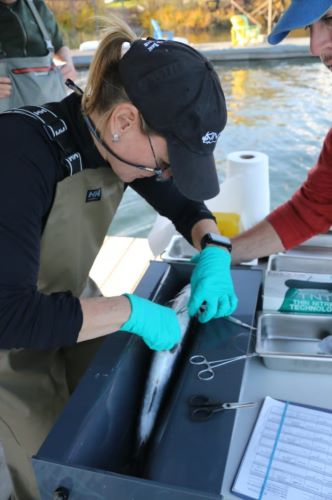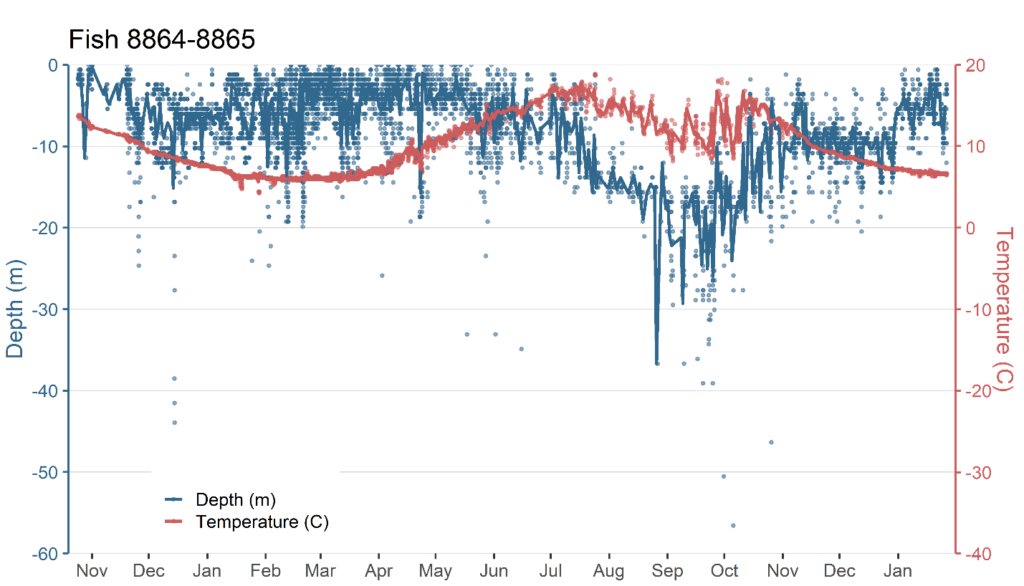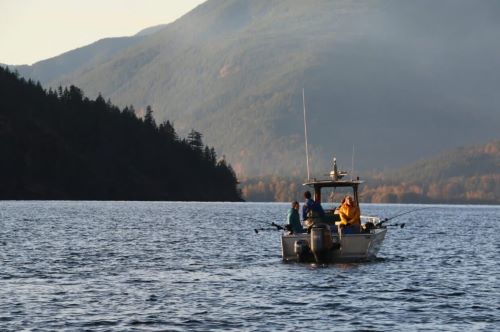Study objectives
A tagging program on Cowichan Lake is shedding light on Vancouver Island’s largest wild, freshwater fishery. The six-year project will provide valuable insights into the life history, movements, and causes of mortality of cutthroat trout in Cowichan Lake.
Provincial biologists teamed up with Nanaimo-based Kintama Research Services (a consulting company with expertise in fish tracking) to attach acoustic tags onto catchable-sized cutthroat trout and monitor their movements in the lake.
The study was started in 2019 to improve biologists’ understanding of cutthroat mortality due to natural causes versus being captured in the fishery. Cowichan Lake supports a popular, limited-harvest fishery for cutthroat trout, and has done so for years. However, recent surveys suggest that angler effort has declined to an all-time low, and catch data suggests that fewer and smaller fish are available for the fishery. Without some indication of what’s going on in this cutthroat population, it’s difficult to determine if fishing regulations need to be updated.
Also of interest is the piscivorous (fish-eating) wild cutthroat population’s co-existence with kokanee. Most of the large-lake cutthroat trout fisheries on Vancouver Island have this same species-pairing, but research into these kinds of fish communities – and our understanding of cutthroat trout movements and behaviour in the presence of kokanee – is limited. What is clear is that kokanee provide an excellent food source for these cutthroat, which allows them to grow to impressive sizes at maturity (with some specimens reaching lengths of more than 60 centimetres).
The cutthroat trout in Cowichan Lake are adfluvial, meaning they spawn in the inlet streams around the lake, and then migrate as juveniles into the lake’s more productive habitats, where they generally stay until they reach maturity. In a sizeable lake like Cowichan, which has three sub-basins, there are plenty of options to either hunker down in one area, or explore farther to seek out prey. Biologists have wondered to what extent individual fish use different areas: are there sub-populations that restrict themselves to just one section, or do the fish move around the whole lake? Does in-lake movement change with season or depend on fish size? What types of movements do mature fish make before and after spawning? Addressing these types of questions helps to identify vulnerabilities of fish at different stages of their lives, and provides context when interpreting (or designing) fisheries surveys.
Tags will help answer study questions
To answer these questions, the team are using two key tools: high-reward external tags and surgically implanted acoustic tags. Each tag type provides different information and, collectively, paint a picture of the causes of mortality for cutthroat trout in Cowichan Lake.
High-Reward Tags
Since 2019, a total of 154 cutthroat trout have been tagged with high-reward spaghetti tags, 97 of which are still at large in the lake. Such high-reward tags have been successfully used in other lakes on Vancouver Island, including Horne and Comox, to encourage anglers to report the date and location of their catch.
Anglers who catch and report fish with a high-reward tag provide critical information to researchers on fishing rates and fishing-related mortality rates. If you catch a tagged fish, whether you release it or keep it (if regulations allow), RETAIN THE TAG to collect your reward. If you are releasing the fish, either by choice or because of regulation, you can clip the tag near the base with scissors or nail clippers, and call the number on the tag to claim your $100 reward. Remember to follow best practices for handling and releasing your catch.


Acoustic Transmitters
93 trout have been implanted with acoustic transmitters, which will send out signals for two to three years, and are tracked by an array of semi-permanent acoustic receivers that have been placed in the lake. Receivers are also being seasonally deployed at key spawning streams to track spawner migrations during the spring. All receivers are downloaded periodically, and transferred to a geospatial mapping program that tracks fish movement over time. As well, more fish will be added to the study next year.
Twenty (ten each year) of these tags also record the temperature and depth of water that a fish is using. The figure below shows temperature (in red) and depth (in blue) used by one of these fish (a three-year-old that was 37.5 cm when captured and released in October 2019). You can see that during the cooler periods of the year, this fish generally stayed in shallower water, and in the summer moved to deeper water to take advantage of the cool temperatures below. This seasonal, temperature-based movement is likely common for cutthroat trout in the large lakes of Vancouver Island.

Early results
When biologists combine information from both the high reward and acoustic tags a picture starts to emerge. Fifteen tagged cutthroat trout have been caught and reported by anglers to date (~10%). Based on data from the fish tagged in 2019, it appears that mortality by natural causes is greater than mortality due to harvest; the information at hand suggests that spring is a time of significant natural mortality for cutthroat trout in Cowichan Lake, which is likely related to post-spawning mortality of mature fish. Further years of data will help clarify this assumption.
This multifaceted investigation into Cowichan Lake cutthroat trout is still in its early stages, but is already producing some interesting insights into fish behaviour and angler use. The data suggest that during this time, most fish tend to stay within the sub-basin where they were originally tagged, but some fish do move around significantly.
Over the next five years, the results of this study will help to best manage this special wild cutthroat trout population, and ensure that anglers continue to enjoy the quality fishery.
Watch tagged fish movement on an interactive animator
The movements of acoustically tagged fish between can be viewed via Kintama’s open access, interactive animator. The animator can be panned, zoomed, and queried. Users can customize the animation by changing many options using the left-hand menu, including choices to increase or decrease the speed of the animation (Timing tab) or view fish by zone (Query tab). By pausing the animation and right- or left-clicking on a fish or a receiver, additional information can be displayed.
Try this! Select ‘Query’ and in the Tag ID field enter: 58824. Press the play button.
You can see that some fish like the 47 cm #58824 are broad ranging in their movements, while others like the 24 cm #58847 are more localized (Hint: in the ‘Timing’ tab change the Target Duration to 30 seconds to see this sped up). Researchers suspected a broader use of the lake by larger (older) fish and so planned their tagging to account for fish in all parts of the lake, and at various sizes. These size-structured and spatial considerations around tagging will allow researchers to detect differences in movement as fish age through sub-adult to adult life stages. The data keep piling in – there is much more to come!
This initiative is a joint project between provincial biologists and Kintama Research Services. The project is funded in partnership with the Habitat Conservation Trust Foundation and the Freshwater Fisheries Society of BC.
Author: Sue Pollard, Freshwater Fisheries Society of BC; and Jennifer Sibbald, Ministry of Forests, Lands, Natural Resource Operations and Rural Development.
